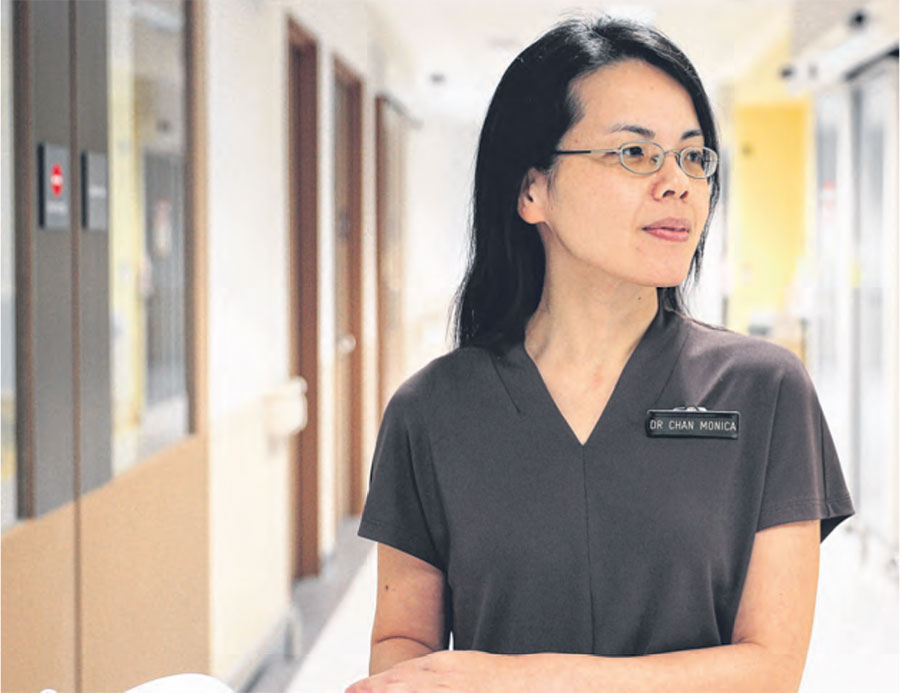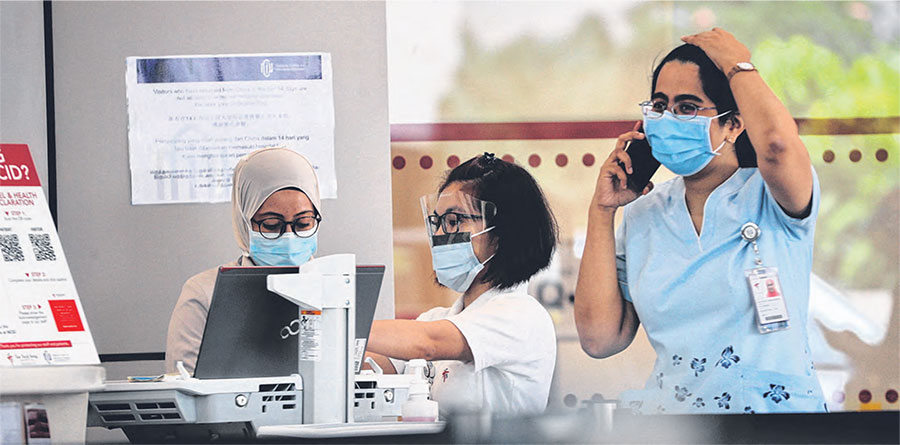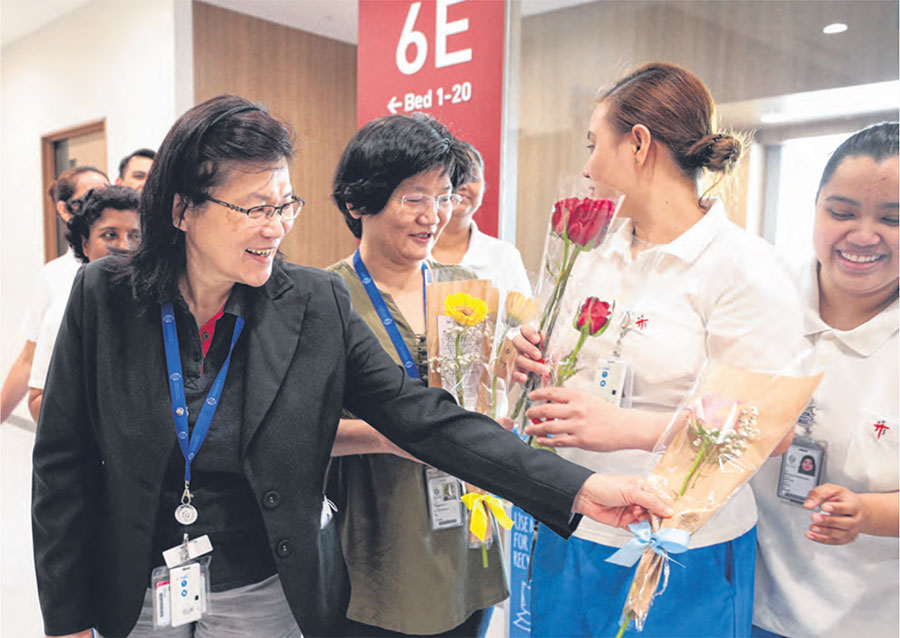 Dr Monica Chan says it was “anxiety-provoking” when the National Centre for Infectious Diseases confirmed its first coronavirus case.
Dr Monica Chan says it was “anxiety-provoking” when the National Centre for Infectious Diseases confirmed its first coronavirus case.
ST PHOTO: JASON QUAH
The Straits Times (16 February 2020)
A doctor tells of seeing her young daughters for only half an hour each day, while others share the challenges and fears they face in the fight against the coronavirus
At the heart of the outbreak battle, the National Centre for Infectious Diseases (NCID), where most coronavirus patients have been taken, senior consultant Monica Chan reflects on what it has meant to her family.
Since late last month, as the number of suspected and confirmed coronavirus cases grew, Dr Chan has managed to see her two daughters, aged nine and 11, for only about half an hour each day before they sleep.
When she is unable to do so, she stays in touch through a video call.
A check of Singapore’s public hospitals shows the challenges and fears faced by healthcare staff in the line of duty, who put in extra work hours as days turn into weeks and possibly into months.
Of Singapore’s scores of cases, several are in critical condition, while some have been discharged, and for every confirmed case, there are more suspected ones.
Patients started checking in to the 330-bed NCID at the start of the year. Some sought help at hospitals including Changi General Hospital (CGH), National University Hospital (NUH) and Sengkang General Hospital.
Singapore’s first confirmed case, a Chinese tourist from Wuhan, went to Singapore General Hospital on his own as that was the nearest one from his hotel in Sentosa.
NCID’s first confirmed case, and Singapore’s second, was announced on Jan 24. The patient had sought help at a hospital and was subsequently transferred to the centre.
While all major hospitals in Singapore have isolation rooms for patients with suspected infectious diseases, NCID, which opened last year, was built specifically to combat outbreaks such as the current coronavirus outbreak.
It has the largest number of special isolation rooms among Singapore’s healthcare facilities, and also houses the National Public Health Laboratory, where swabs are sent to check if a patient has the coronavirus infection.
As patient numbers rise, NCID has deployed more medical teams on the ground. Dr Chan says doctors from neighbouring Tan Tock Seng Hospital (TTSH) have been roped in to help out, leave has been frozen and most training has been cancelled.
Over the past week, regular patients at NCID have been transferred to TTSH as the centre prepares to handle more coronavirus patients, if needed.
Each day now, a team of two or three doctors may see 10 to 20 patients who have or are suspected of having the coronavirus disease, up from five to 10 patients normally before the outbreak, says Dr Chan.
They must wear personal protective equipment (PPE) each time they go into an isolation room to see a patient. That was not always the case previously.
Dr Chan says it can take five to 10 minutes to put on the gear, which includes an N95 mask, a visor, a gown and gloves, and another five to 10 minutes to remove it very carefully.
“We minimise unnecessary entry into a patient’s room, and so it’s probably twice a day,” she says.
Before the coronavirus reached Singapore, NCID had done a lot of outbreak planning and training, and conducted drills, she says.
 Staff at the National Centre for Infectious Diseases, which was built specifically to combat outbreaks such as the current coronavirus outbreak. It has the largest number of special isolation rooms among Singapore’s healthcare facilities and also houses the National Public Health Laboratory.
Staff at the National Centre for Infectious Diseases, which was built specifically to combat outbreaks such as the current coronavirus outbreak. It has the largest number of special isolation rooms among Singapore’s healthcare facilities and also houses the National Public Health Laboratory.
ST PHOTO: JASON QUAH
She adds that despite the preparations, when the first patient at NCID tested positive in a preliminary test on the evening of Jan 23, it was “anxiety-provoking”. It was about 5pm when the medical team received the results and they had to go back to the ward to announce the news.
In the wards, they monitor each patient closely, as a patient’s condition can worsen at the end of the first week, when shortness of breath can progress quite rapidly, Dr Chan says.
“I’m never sure what the day will bring because you don’t know where the next new patient will be found, and whether there will be an increase in the number of patients coming in,” she says.
Direct confirmatory testing for the virus by the laboratory at NCID became available from the second week of January, which helped to cut down the time that doctors took to diagnose a patient.
“This reduced the uncertainty and waiting to see if symptoms worsen,” says Dr Chan.
“As symptoms of the coronavirus are similar to the common cold and flu, the direct confirmatory testing allowed NCID to quickly sift out those who did not have the virus.”
Dr Kelvin Kuan, a consultant at CGH’s accident and emergency department, says any initial fear among medical staff diminished as the hospital infection control put them through a refresher course on using PPE, “which was uncomfortable but something we could trust in providing us with protection from the virus”.
One of the challenges was getting patients’ travel history. “While being led to the isolation room, some patients expressed regret at revealing their travel history,” he says.
Then, as the travel ban took effect and cases of local spread were reported, the medical team knew that they had to be even more vigilant.
“Now, anyone can be a patient,” Dr Kuan says.
“Despite that, we had already planned ahead with this scenario in mind, and the A&E was split into different sections to prevent the mingling of those at a higher risk of the virus with those at a lower risk.”
Dr Tan Seow Yen, a consultant at CGH’s infectious diseases department, admits: “When treating an infected patient, I did worry about potentially infecting my family. ButI kept telling myself that the PPE would protect me adequately.”
Dr Ian Mathews, a consultant at NUH’s emergency department, says: “New work flows that we have implemented for affected patients will change frequently the more we discover about the disease.”
Staff who see patients with fever and respiratory illness on the front line and in high-risk areas put on PPE for the majority of their shift, which ranges from eight to 12 hours, he says.
In some cases, they have to wear the full PPE for a prolonged period. “We are drenched (in sweat) after minutes of use.”
 NCID executive director Leo Yee Sin with flowers for her staff from the public. With her are (from left) director of nursing Margaret Soon and nurses Ma. Olivia Valencia Valiente and Nurul Hazirah Subari. ST PHOTO: JASON QUA
NCID executive director Leo Yee Sin with flowers for her staff from the public. With her are (from left) director of nursing Margaret Soon and nurses Ma. Olivia Valencia Valiente and Nurul Hazirah Subari. ST PHOTO: JASON QUA
'Taking care of everybody' at centre for infectious diseases
She is right on the front lines in the coronavirus fight, as executive director of the National Centre for Infectious Diseases (NCID) – where the bulk of patients are cared for in specially constructed isolation rooms.
This is the sort of pressure Professor Leo Yee Sin, 60, faces: There are at least twice as many patients in the wards than normal, with close to 60 from the current outbreak, and more expected.
She has "to take care of everybody", as she puts it, making sure the infrastructure – only a year old – is able to stand up to the sudden heavy load.
The 330-bed NCID building also houses the National Public Health Laboratory which tests samples from suspect patients for the coronavirus – and from where the confirmation of their illness comes.
Prof Leo now also supports the Ministry of Health as she reports directly to its director of medical services.
Then, there is the pressure of the ever-changing nature of the virus itself. She says: "This outbreak is very challenging. It is not mild and we haven’t seen the end yet. The situation is still evolving."
Generally, those who get very sick take a turn for the worse after five to seven days of illness.
A handful of patients with severe conditions have done well and no longer need intensive care.
But she is very worried for one "who has been unable to get himself out of intensive care and still requires mechanical ventilation".
She adds: "I do anticipate that one of these days, we will have a fatal case. What we want to do is to minimise the number (of fatalities) as much as we possibly can."
Her role today is far bigger than during the severe acute respiratory syndrome (Sars) outbreak in 2003. Then, she had just a clinical role caring for patients and advising policymakers on the medical situation.
Compared with Sars, the cases this time are escalating much faster. Because of the quick increase in coronavirus patients and the need to screen many more patients for the disease, she needed to bring in staff from Tan Tock Seng Hospital next door, since even the numbers of buffer staff were not enough.
Says Prof Leo: "We have to come out of our norm, to handle something that is very different.
We have adapted a workflow to make sure that we can function, and function safely."
But she adds that many of the doctors and nurses are “old troop” who have handled other outbreaks, like Sars, the Nipah virus and Zika, so their experience is proving very useful.
Still, she says that 24 hours a day is just not enough: "I need at least 28, even 36 hours a day."
What has to give is her sleep and personal life, but that is part of her job and her husband is very understanding, she says, knowing that at times like this, "family becomes secondary". Her three children are grown up.
"The virus doesn’t take time off, no weekends or holidays. It is running very fast, so we need to be faster, to be ahead of the curve."
As with Sars, people have been very supportive, she says, offering her staff at NCID free food, drinks, snacks and flowers.
She is also grateful to the 2,000 Grab drivers who have stepped forward with offers to ferry staff to and from the hospital.